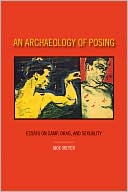 An Archaeology of Posing: Essays on Camp, Drag, and Sexuality
An Archaeology of Posing: Essays on Camp, Drag, and Sexuality
by Moe Meyer
Macater Press. 221 pages, $24.95
“CAMP” is a slippery term with an array of denotations ranging from generally humorous, corny, or sentimental to specifically effeminate or gay. Moe Meyer argues that the only genuine “Camp” (with a big C) is exclusively a gay phenomenon, or in his terms: “the process for the social signification of gayness—the production of gay social visibility.” An Archaeology of Posing: Essays on Camp, Drag, and Sexuality is a collection of performance studies essays previously published between 1992 and 1997, and two new essays.
One of Meyer’s recurring complaints is that Susan Sontag’s “Notes on Camp” (1964) and the academic work that followed in its footsteps over-generalized camp as an æsthetic, shifting from performances to objects, embracing Warhol’s Pop Art, Tiffany lamps, and tacky tchotchkes. You wouldn’t know from his attack on Sontag that she specifically identified camp as a homosexual æsthetic. Meyer’s second pet peeve is that queer studies, in its love affair with “performativity,” has discounted or trivialized actual “performance.”
The final essay, co-authored with Thomas King, focuses on this issue. Performativity (as defined by Judith Butler) is the compulsory, non-conscious re-enactment of social norms that generates seemingly natural phenomena such as gender, sex, or even homosexuality. Meyer and King propose a return to actual performance—whether drag queens on stage or mincing pansies on the street—as a way to recover the possibility of agency in sexual politics. However, they so exhaustively criticize performativity that they never get around to demonstrating what an analysis of performance can do for our understanding of gay identity, culture, and pleasure. Like much of high queer theory, the intellectual debate is largely unhitched from any specific reality. It’s like arguing about how many angels can dance on the head of a pin and proving that more can fit if they are disco dancing rather than waltzing.
Meyer is more informative when he examines specific performances, including: an I Dream of Jeannie strip tease; the vogueing competitions in the movie Paris Is Burning (1990); and the public effeminacy of 19th-century sexual inverts. He persuasively argues for the value of performance studies in these detailed ethnographies. He examines the space where camp or drag performances occur, how they code gender and sexuality, and how they become a political means of defining and celebrating a minority identity in resistance to a variety of oppressive norms—whether of class, race, gender, or sexuality.
However, I often found myself at odds with the details of his analysis. I wasn’t persuaded by his association of vogueing houses in Paris Is Burning with African diaspora Santería houses. He also completely overlooks Hispanics in this documentary. His claim that the term “straight-acting” is an Internet term is historically inaccurate. Any gay man over thirty must recall classified personal ads (in print!) that simply used the acronym SASA—straight acting, straight appearing (the term’s onomatopoetic swishiness seemed to undermine the very claim of masculinity). Despite some questionable claims, Meyer’s central argument is worthy: GLBT studies should pay more attention to specific queer performances and spaces and mine them for all their deliriousness, sexiness, and in-your-face defiance of social norms.
________________________________________________________
Vernon Rosario is a medical historian and child psychiatrist based in Los Angeles.





